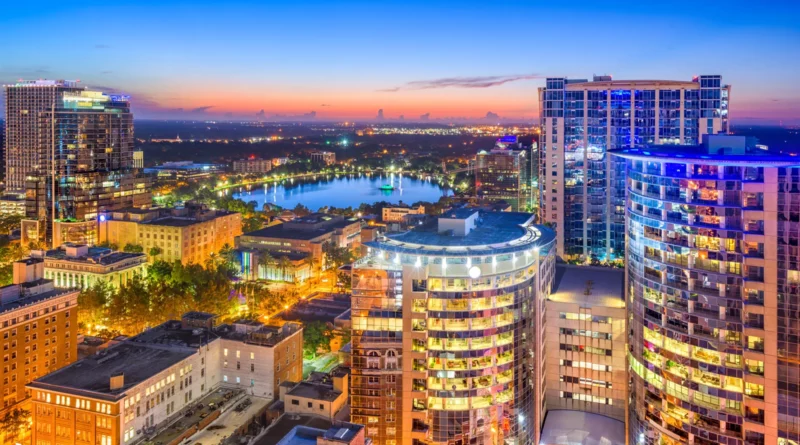History of Orlando Florida
Orlando, Florida, is one of the most popular tourist destinations in the world, known for its theme parks, sunny weather, and vibrant cultural scene. But before it became the home of Walt Disney World and Universal Studios, Orlando had a rich and diverse history shaped by indigenous peoples, European settlers, and significant economic transformations. This article delves into the fascinating history of Orlando, tracing its development from its early days as a frontier town to its status as a global entertainment hub.
The Pre-Columbian Era: Native American Roots
Before European settlers arrived, the area now known as Orlando was inhabited by Native American tribes, most notably the Timucua and the Seminole people. These tribes thrived in the region, taking advantage of the abundant natural resources, including the many lakes and rivers that dot the landscape. The Timucua were known for their complex social structures, advanced agricultural practices, and impressive mound-building techniques. However, the arrival of European explorers in the 16th century marked the beginning of significant changes for the indigenous population.
European Exploration and Early Settlement
The first Europeans to explore Central Florida were Spanish conquistadors in the early 1500s. Juan Ponce de León is believed to have been the first European to set foot in Florida in 1513, although he did not venture into the interior where Orlando is located. Subsequent Spanish explorers, such as Hernando de Soto, traveled through the region in search of wealth and resources, but it wasn’t until the 18th century that European settlement began to take hold.
In 1763, Florida was ceded to the British by Spain, leading to increased colonization efforts. The British established plantations and encouraged settlement through land grants, but their control was short-lived. By 1783, Florida was returned to Spanish rule, and it wasn’t until 1821 that the United States acquired Florida from Spain, opening the door for American settlers to move into the area.
The Founding of Orlando: From Fort Gatlin to Cityhood
Orlando’s origins as a settlement can be traced back to the establishment of Fort Gatlin in 1838 during the Second Seminole War. The U.S. Army built the fort south of present-day Orlando to protect settlers from the Seminole Indians, who were resisting relocation to reservations in the West. A small community began to grow around the fort, attracting pioneers who were drawn to the fertile land and the potential for agricultural development.
The settlement was initially known as Jernigan, named after the first permanent settler, Aaron Jernigan, who arrived in the area in 1843. Jernigan’s homestead became a focal point for the community, and the area began to grow. However, in 1857, the name of the settlement was officially changed to Orlando. The origins of the name “Orlando” are somewhat murky, with several competing legends. One popular story claims that it was named after a soldier named Orlando Reeves who died in the area during the Seminole Wars, while another suggests it was named after a character from Shakespeare’s play “As You Like It.”
Orlando was incorporated as a city in 1875 with a population of just 85 people. Despite its small size, the city began to grow steadily, driven by the arrival of more settlers and the development of the local economy.
The Citrus Industry Boom
The late 19th century saw Orlando’s economy thrive, thanks in large part to the citrus industry. The region’s warm climate and fertile soil made it an ideal location for growing citrus fruits, particularly oranges. By the 1870s, orange groves were being planted throughout Central Florida, and Orlando quickly became the hub of the state’s burgeoning citrus industry.
The citrus boom brought wealth and prosperity to the area, leading to rapid growth in population and infrastructure. Railroads were constructed to transport the fruit to northern markets, and Orlando’s downtown area began to develop with new businesses, homes, and public buildings. The city became known as “The City Beautiful,” a moniker that reflected its lush, green landscapes and the wealth generated by the citrus trade.
However, the boom was not without challenges. In the winter of 1894-1895, a series of devastating freezes, known as the Great Freeze, wiped out much of the citrus crop, causing economic hardship for many growers. Despite this setback, the industry rebounded, and citrus continued to play a significant role in Orlando’s economy well into the 20th century.
The Impact of the Civil War
Like much of the South, Orlando was deeply affected by the Civil War. Florida seceded from the Union in 1861, and Orlando residents, like those in many Southern towns, were divided in their loyalties. While the city itself saw little direct combat, the war disrupted the local economy and brought hardship to many families.
After the war, Orlando, like much of the South, went through a period of Reconstruction. The end of the war also led to the expansion of the railroads, which would become a critical factor in Orlando’s post-war growth and development. The city’s recovery was slow, but the citrus industry helped to revitalize the economy, paving the way for future growth.
Orlando’s Growth in the Late 19th Century
The years following the Civil War were a time of rebuilding and growth for Orlando. The city became a vital commercial center for the region, thanks in large part to its central location and its role as a hub for the citrus industry. The arrival of the South Florida Railroad in 1880 connected Orlando to the rest of the state, making it easier to transport goods and attracting new residents and businesses to the area.
The city’s population grew rapidly during this period, and by the turn of the century, Orlando had become a bustling town with a thriving downtown area. New public buildings, including schools, churches, and a courthouse, were constructed, and the city began to develop a reputation as a desirable place to live and do business.
The Arrival of the Railroad and Economic Expansion
The arrival of the railroad in Orlando was a turning point in the city’s history. The South Florida Railroad, which reached Orlando in 1880, connected the city to Sanford and eventually to Tampa, opening up new opportunities for trade and commerce. The railroad made it easier to transport citrus and other agricultural products to markets in the North, fueling further growth in the local economy.
The railroad also brought new residents to the area, including investors, entrepreneurs, and tourists. Hotels and boarding houses were built to accommodate the influx of visitors, and Orlando began to develop a tourism industry that would later become one of its most important economic drivers.
The Land Boom of the 1920s
The 1920s were a time of tremendous growth and speculation in Florida, and Orlando was no exception. The Florida land boom attracted investors from across the country who were eager to buy up land and develop new communities. Orlando’s population grew rapidly during this period, and new neighborhoods, commercial districts, and infrastructure projects were developed to accommodate the influx of residents.
Real estate prices soared, and the city experienced a building boom, with new hotels, theaters, and office buildings transforming the downtown area. However, the boom was short-lived. By the late 1920s, the land bubble had burst, and the Great Depression soon followed, bringing economic hardship to the city once again.
The Great Depression and Its Aftermath
The Great Depression had a significant impact on Orlando, as it did on communities across the country. The real estate market collapsed, and many businesses failed. Unemployment rose, and the city’s growth came to a halt. However, despite the economic challenges, Orlando managed to weather the storm better than some other parts of the country.
New Deal programs provided much-needed relief, funding public works projects that improved the city’s infrastructure and provided jobs for residents. The Works Progress Administration (WPA) and other federal programs helped build roads, schools, and other public facilities that would serve the community for years to come.
World War II and the Birth of the Defense Industry
World War II brought new opportunities for Orlando, as the city became a key player in the nation’s defense efforts. The Orlando Army Air Base (now Orlando Executive Airport) was established, and the city became a training center for military personnel. The influx of soldiers and defense workers boosted the local economy and led to further growth in the post-war years.
The war also marked the beginning of Orlando’s relationship with the defense industry, which would play a significant role in the city’s economic development in the decades to come. After the war, many veterans chose to settle in Orlando, contributing to the city’s post-war population boom.
The Walt Disney World Effect: Transforming Orlando
Orlando’s most significant transformation came in the 1960s when Walt Disney announced plans to build a massive theme park resort in Central Florida. The construction of Walt Disney World, which opened in 1971, was a game-changer for Orlando, turning the city into one of the world’s top tourist destinations almost overnight.
The opening of Walt Disney World brought millions of visitors to Orlando each year, spurring the development of new hotels, restaurants, and attractions. The success of Disney World also attracted other major theme parks, such as Universal Studios and SeaWorld, further solidifying Orlando’s reputation as the “Theme Park Capital of the World.”
The impact of Disney World on Orlando’s economy cannot be overstated. The city experienced explosive growth in the 1970s and 1980s, with new residential and commercial developments springing up to accommodate the influx of tourists and new residents. The tourism industry became the dominant force in the local economy, providing jobs and opportunities for thousands of people.
The Growth of Tourism and Entertainment
The success of Walt Disney World set the stage for the growth of Orlando’s tourism and entertainment industries. Throughout the 1980s and 1990s, new theme parks, hotels, and entertainment complexes were developed, attracting visitors from around the world. The construction of Universal Studios Florida in 1990 and the opening of the Islands of Adventure theme park in 1999 added to Orlando’s appeal as a global destination for family entertainment.
The International Drive corridor became a major hub of tourism activity, with new attractions, shopping centers, and restaurants catering to the millions of visitors who flocked to Orlando each year. The city’s airport, Orlando International Airport, expanded to accommodate the growing number of tourists, becoming one of the busiest airports in the country.
The Development of the International Drive Corridor
The International Drive corridor, often referred to simply as I-Drive, has become synonymous with Orlando’s tourism industry. Stretching for over 11 miles, I-Drive is home to some of the city’s most famous attractions, including the Orange County Convention Center, ICON Park, and a wide range of hotels, restaurants, and entertainment venues.
The development of I-Drive began in the 1970s as a response to the growing number of tourists visiting Walt Disney World. Over the years, it has evolved into a bustling entertainment district, offering something for everyone, from high-end dining and shopping to family-friendly attractions. I-Drive has played a crucial role in Orlando’s economic growth, drawing millions of visitors each year and contributing to the city’s status as a top global tourist destination.
The Role of Technology and Education
While tourism has long been the cornerstone of Orlando’s economy, the city has also become a hub for technology and education in recent years. The presence of major defense contractors, such as Lockheed Martin and Siemens, has led to the development of a thriving high-tech industry in the region. Orlando is now known for its advancements in simulation, aerospace, and digital media, attracting businesses and talent from across the country.
The city is also home to several institutions of higher education, including the University of Central Florida (UCF), one of the largest universities in the United States. UCF has played a significant role in Orlando’s growth, providing a skilled workforce and fostering innovation in fields such as engineering, computer science, and hospitality management.
Orlando Today: A Modern Metropolis with Global Appeal
Today, Orlando is a dynamic and diverse city that continues to attract millions of visitors each year. Its economy is driven by tourism, technology, and education, and it is home to a vibrant cultural scene that includes world-class museums, theaters, and music venues. The city has also become known for its sports teams, including the Orlando Magic (NBA) and Orlando City SC (MLS).
Orlando’s population has grown rapidly in recent decades, making it one of the fastest-growing metropolitan areas in the United States. The city’s diverse population reflects its status as a global city, with residents from all over the world contributing to its rich cultural tapestry.
As Orlando looks to the future, it continues to build on its strengths as a leader in tourism, technology, and education. The city’s commitment to innovation, sustainability, and inclusivity ensures that it will remain a vibrant and thriving metropolis for generations to come.
Discover more from City Towner
Subscribe to get the latest posts sent to your email.




